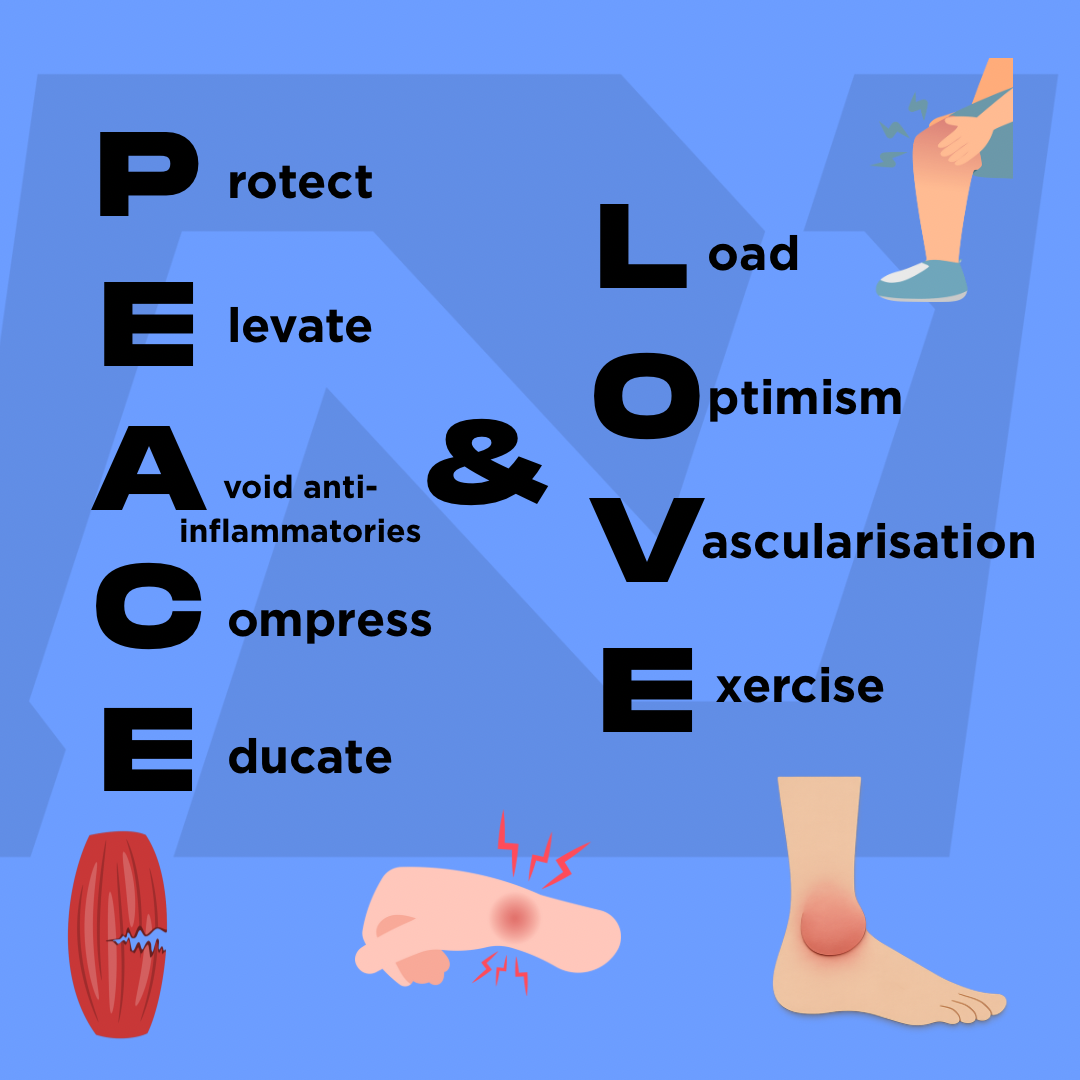PEACE & LOVE: A Modern Approach to Soft Tissue Injury
For decades, the go-to advice for a sprain, strain, or other acute soft tissue injury was RICE (Rest, Ice, Compression, Elevation). While well-intentioned, sports medicine research has evolved, leading to a new, more comprehensive acronym: PEACE & LOVE.
This updated protocol guides what to do immediately after an injury (PEACE) and how to care for it in the following days and weeks (LOVE). As osteopaths, this holistic and active approach to recovery aligns perfectly with our principles of supporting the body’s innate healing abilities.
What Does PEACE Stand For? (The Acute Phase)
In the first 1-3 days after an injury, the goal is to create an optimal environment for healing without impeding it.
P - Protect: Unload or restrict movement for the first 1-3 days to minimise bleeding and prevent further aggravation. This means avoiding activities and movements that cause sharp pain. Important note: This does not mean strict, prolonged immobilisation.
E - Elevate: Elevate the injured limb higher than the heart when possible. This helps to promote fluid drainage from the injured area, which can reduce swelling.
A - Avoid Anti-Inflammatories: This may be surprising. The latest evidence suggests that the inflammatory process is a crucial first step in tissue repair. Routinely using anti-inflammatory medication (like neurofen and voltaren) may potentially disrupt this natural healing process and negatively affect long-term tissue strength. Always consult your GP or pharmacist before making any changes to your medication.
C - Compress: Using elastic bandages or taping can help to limit swelling and provide gentle support to the injured joint. It should be snug but not restrictive.
E - Educate: This is a core part of our osteopathic approach. At Nudge Osteopathy, we believe an educated patient is an empowered one. Understanding your injury and the healing process leads to better outcomes and avoids unnecessary treatments. We will explain the expected recovery timeline and the importance of an active approach.
What Does LOVE Stand For? (The Subsequent Management)
After the initial few days, the focus shifts to active recovery and rebuilding.
L - Load: Let pain be your guide. Gradually resuming normal activities and adding load (like weight-bearing) as soon as it is comfortable encourages repair and remodelling of the tissue. Active recovery, without aggravating pain, is key.
O - Optimism: Your mindset matters. Psychological factors like fear, catastrophising, and depression can be barriers to recovery. Staying optimistic and confident in your body's ability to heal is associated with better outcomes and a quicker return to function.
V - Vascularisation: This involves choosing pain-free cardiovascular exercise early in the recovery process. Activities like walking, cycling, or swimming increase blood flow, which delivers essential nutrients to the injured area and promotes repair.
E - Exercise: A cornerstone of rehabilitation. Specific exercises are vital to restore mobility, strength, and proprioception (your body's sense of position). This helps to prevent re-injury and addresses any underlying biomechanical issues that may have contributed to the injury in the first place.
How Osteopathy Complements PEACE & LOVE
The PEACE & LOVE protocol provides an excellent framework, and osteopathic care fits seamlessly within it, particularly in the Educate and Exercise components.
An osteopath can:
Provide an Accurate Diagnosis: We perform a thorough examination to determine the exact tissues involved and rule out other potential issues.
Address Contributing Factors: We look at your body as a whole. An ankle sprain, for example, can affect the knee, hip, and pelvis. We use hands-on techniques to improve joint mobility, release muscle tension, and correct imbalances throughout the body to support healing and prevent future problems.
Guide Your Load and Exercise: We provide individualised advice and a tailored exercise program that ensures you are loading the tissue appropriately and progressing safely through your rehabilitation.
Support Your Optimism: We help you understand your injury and recovery pathway, which can significantly reduce anxiety and build confidence.
When to Seek Help
While PEACE & LOVE is a great self-management strategy, it is crucial to get a proper diagnosis. Please consult an osteopath, physiotherapist, or your GP for:
An injury that causes severe pain, significant inability to bear weight, or joint instability.
Numbness, tingling, or weakness radiating from the injury site.
Any injury that does not start to improve within a few days.
If you are unsure about the nature or severity of your injury.
Take a Modern Approach to Your Recovery
Understanding modern injury management protocols like PEACE & LOVE empowers you to take an active role in your health. Osteopathy can be your guide through this process, providing hands-on treatment and expert advice to ensure you heal completely and effectively.
Click here to schedule an appointment with Niraj. Let us help you navigate your recovery with knowledge and confidence.
References
Dubois, B., & Esculier, J. F. (2020). Soft-tissue injuries simply need PEACE and LOVE. British Journal of Sports Medicine, 54(2), 72-73. https://bjsm.bmj.com/content/54/2/72
Vuurberg, G., et al. (2018). Diagnosis, treatment and prevention of ankle sprains: update of an evidence-based clinical guideline. British Journal of Sports Medicine, 52(15), 956. https://bjsm.bmj.com/content/52/15/956
Disclaimer: This blog post provides general information only and is not intended as a substitute for professional health advice, diagnosis, or treatment. Always consult a registered health practitioner, such as your General Practitioner (GP) or osteopath, for diagnosis and treatment of health conditions. The information provided, including the advice on anti-inflammatories, is based on the best available evidence at the time of publication and is for educational purposes. Do not make any changes to your prescribed medication without first consulting your doctor. Individual results from osteopathic treatment may vary.

